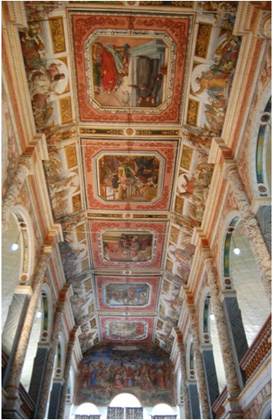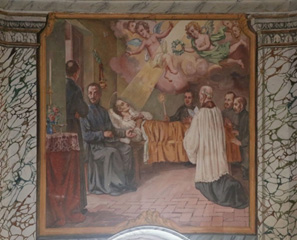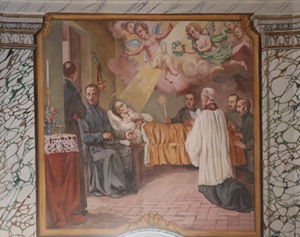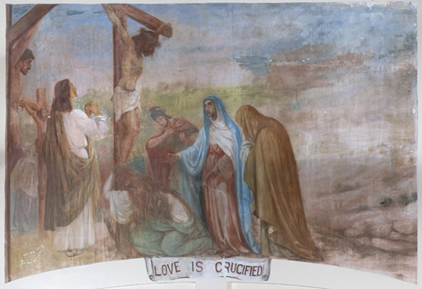Wall Painting Conservation
Wall paintings are paintings executed on walls as support and are an integral part of architectural decorations. Primitive or prehistoric man painted on bare rock in rock shelters or in caves. These rock pictures symbolize man’s first artistic expression, which later developed with time into elaborate wall paintings seen on the walls of tombs, temples, churches, civic buildings, and a variety of outdoor spaces. The richness of wall paintings is founded on the variety of cultural expressions, aesthetic achievements, and the diversity of materials and techniques.
Anatomy
Although the anatomy of wall paintings varies to a great extent depending on the technique and materials employed, a general anatomical structure includes the following elements:
Support/ Carrier
The support carries the picture and the term is applied to natural or dressed rock, or to a wall (artificial or natural) on which the painting has been executed, either directly or on a previously applied rendering or ground.
Ground
The wall support to be painted may be too porous or too compact so paint cannot be applied on the surface with ease. The walls are therefore plastered to get a smooth and less porous surface for the execution of paintings. The plaster applied on the support to fill up its physical irregularities and to obtain a smooth surface with suitable porosity for execution of paintings is called ‘ground’

Layers in a wall painting
The ground is often composed of a number of layers. In India, the first is usually a very coarse layer of plaster made of various materials such as clay, mud, lime, gypsum with additives such as hair, husk, plant fibres, etc. The final finer layer that provides a flat smooth surface for painting maybe a very finely ground plaster or lime coating. The materials of ground show wide variations in their contents over different regions. Variations in materials of the ground depend upon their availability locally, and upon requirements of the techniques to be employed for execution of the painting. After the plaster is ready, pre-liminary drawings are made and transferred on the ground to facilitate application of the paint. These drawings are made through incision, pouncing of the cartoon or through stencil.
Paint layer
The top layer of wall painting is the paint applied on the ground. The paint is composed of a pigment or mixture of pigments dispersed in water in case of fresco paintings or pigments with a binding medium (gum, glue, etc.) in case of tempera paintings. The function of the binding medium is to provide: adhesion of the pigment particles with ground, cohesion
between the pigment particles and the intended gloss to the paintings.
TECHNIQUE
On the basis of techniques used in the execution of wall paintings, they can be classified as under:
Fresco-buono
Fresco refers to a painting executed on fresh lime plaster whilst still moist. The pigments, mixed with water are brushed onto the ground layer called ‘intonaco’, that are fixed by carbonization of lime (calcium hydroxide) contained in the plaster.
Fresco-secco
Fresco-secco is a technique of painting with lime which consists of applying pigments mixed with milk of lime or limewater onto a dry ground previously dampened in order to promote adherence. The lime, with which the pigments have been mixed, acts as a binder in this painting technique. The technique of ‘secco’ is somewhat easier but lacks the durability and shine of the ‘buono’.
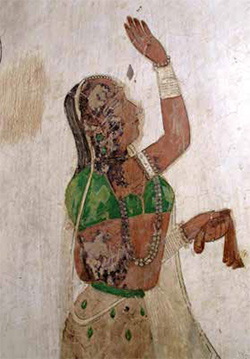
Wall painting in Ala-gila technique
Ala-gila
This is an indigenous Indian technique of fabrication of wall painting that can be loosely termed wet fresco. The painting is laid on fresh lime plaster with pigments mixed with an organic binder or binding medium. Although the pigments are applied over a wet plaster surface, unlike frescos, the pigments are mixed with the binding material in this technique hence it is a tempera. Burnishing and polishing give an extra lustre to the wall paintings in the Ala-gila technique.
Tempera
The Tempera technique involves execution on dry plaster. The pigments are mixed with a medium, either aqueous or in emulsion, which fixes them as it dries. The main tempera binders used are egg, casein, animal glue and certain vegetable gums. Most of the wall paintings in India are executed using the tempera technique

Wall painting in tempera technique
(Mangyu, Ladakh)
DETERIORATION OF WALL PAINTINGS
Wall painting is a layered structure and each of the component layers may be subject to deterioration. The deterioration can be due to; physical or mechanical damage, a chemical reaction or damage due to biological activity. Among the various factors causing damage to a wall painting, moisture is the most potent. The factors of deterioration of wall paintings can be classified as follows:
- Moisture/water
- Temperature
- Light
- Environmental pollution
- Biological growth
- Internal causes
- Faulty restoration
- Human Vandalism
Moisture/ water
Water as such or in the form of moisture, is one of the most potent sources of damage to wall paintings. Water in various forms can cause physical erosion, catalyse chemical reactions and encourage biological
growths such as moulds and fungi. The sources of moisture in the wall are:
- Infiltration of water due to holes in the roof, leaking gutters and down pipes, or to exposure of the wall to rain.
- Rising damp in walls in contact with waterlogged ground.
- Condensation of humid air on cold walls
- Moisture due to the presence of hygroscopic materials.
- Moisture resulting from damp air rising from the ground.
When water in any form, comes in direct contact with the paint layer in wall paintings, it can soften the binding media resulting in the deterioration of the painting. When the paint layer of tempera paintings comes in contact with moisture, it swells and loses its adhesion to the ground. On drying, the paint layer cracks and starts flaking. Subsequent wet and dry cycles may cause falling off of the loosely hanging paint layer leading to major loss.
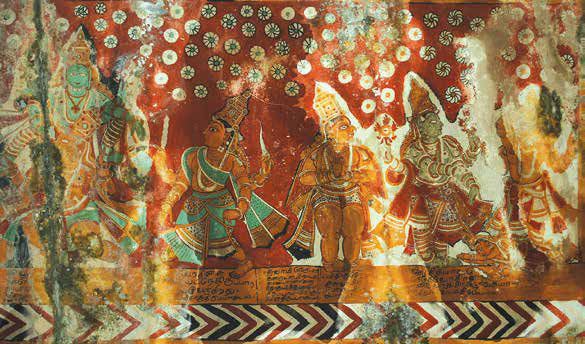
Wall painting damaged due to water running off from the ceiling leading to paint loss and mould growth
Clay plasters are most affected and may be washed away completely because of disintegration of the plaster with water. Efflorescence: Soluble salts present in the water, or those accumulated in the structure can cause damage to paintings. These soluble salts travel along with water through the capillaries of the wall and the layers of painting and on evaporation of water, crystallize either on the surface of paintings or within the structure. This crystallization of salts on the surface is called ‘efflorescence’. Efflorescence on the surface causes damage to the paint layer and obscures details. Crystallization of salts in the plaster leads to mechanical strain due to the increase in its volume and dislodging of the plaster; the outer layers may bulge, crack and may finally fall off. Hygroscopic salts present in the paint layer, preferentially absorb moisture from the atmosphere and keep the painting moist for prolonged periods of time, and thus the deteriorating action of water is further enhanced.
High humidity also encourages the growth of biological growth such as insects and fungus, leading to various types of damage to the paintings.
Temperature
Very high and low temperatures can cause cracking and loosening of plaster and paint layers. Also the deteriorating chemical and biological reactions taking place in the presence of water are accelerated by heat. High temperature also increases the rate of salt efflorescence.
Light
Light is also a potent source of deterioration of wall paintings. Light is a form of energy, and this energy inversely depends upon its wavelength. The smaller the wavelength, the more energy it has and thus more damaging power. Daylight is an intense source of UV radiations and likewise some artificial light sources also emit UV radiations. Under the influence of UV radiations, the binding media of the tempera paintings lose their adhesive and cohesive power. The colour of some pigments also tends to fade on exposure to light.

Detachment of layer due to changes in temperature and relative humidity
Environmental pollution
Various types of impurities in gaseous and suspension form enter into the environment because of urbanization and industrialization. Fire and smoke due to various human activities, also causes pollution of the atmosphere. These pollutants interact with the constituents of wall paintings resulting in weakening, soiling and tarnishing of the paint. Deposition of soot on the wall paintings due to burning of lamps, candles, etc. is a common conservation problem in paintings housed in religious establishments. Vibrations caused by activities such as ground traffic, machines, mine blasting, etc. may also result in crumbling of weakened plaster.
Biological damage
Micro-organisms such as fungi as well as mosses and lichen can grow in damp conditions on wall paintings resulting indisfigurement and physical disintegration. Insects such as termites, silverfish, beetles etc. can also pose a threat. Wall painting shave also been found disfigured with wasp nests and beehives. Disfigurement by excreta of bats and birds is a common occurrence. They also damage the paintings physically by their claws. Higher plants may not be found directly on the wall painting, but their presence anywhere on the structure or close to it, may lead to damage of the wall support
Internal causes
Internal causes refer to the faulty material and/or techniques used by the artist in fabrication of the paintings that may lead to deterioration. These include actions such as
the support not being properly roughened; some extraneous deposit being left on it before the application of plaster; the porous material has not been moistened properly before putting a lime-based plaster, or using a very strong or very weak binding media.
Faulty restoration
Improper and unscientific conservation or repair methods may also lead to damage of this artwork. Choice of wrong conservation material and/or technique of using these may lead to deterioration of the wall paintings in the long run.
INTACH Conservation Centre, Delhi has done the conservation of wall paintings in different states, some of them are as follows: –
- Conservation of Wall Paintings at Mangyu Monastery, Ladakh
- Conservation of Wall Paintings at Chemrey Monastery, Ladakh
- Conservation of Wall Painting Panels at Kirti Mandir
- St. Aloysius Chapel, Mangalore, Karnataka
- Bethany Chapel Conservation Project
- Conservation and Relocation of Art Works WHO Building, New Delhi
Services offered include
- Comprehensive condition survey, Project Proposals, Estimation etc
- Environmental recording and monitoring
- Sampling and material analysis
- Cleaning of painted surfaces
- Consolidation of flaking paint, delaminating plaster layers and disintegrations
- Mortar repairs and grouting
- Sympathetic inpainting
- Transfer of wall painting
- Research and Publication



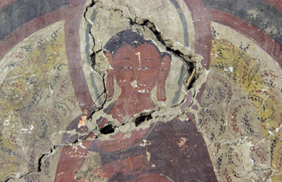
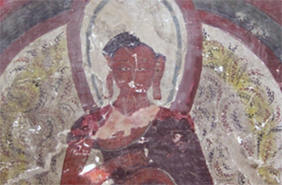
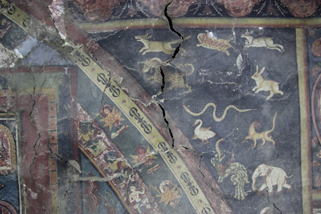
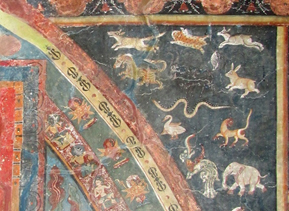

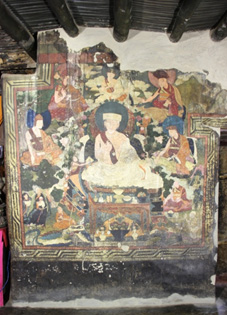
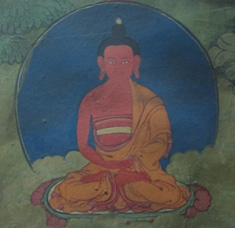
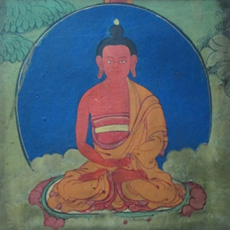
 Before Conservation: Mirabai panel: Kirti Mandir
Before Conservation: Mirabai panel: Kirti Mandir

